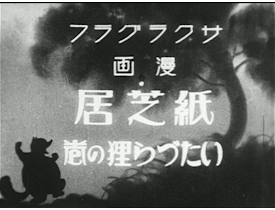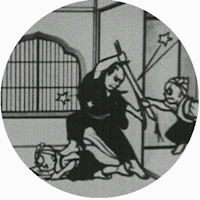Rascal Racoon
| Original Title | 漫画 紙芝居 いたづら狸の卷 |
|---|---|
| Japanese kana Rendering | Manga Kamishibai Itazuratanuki no maki |
| English Title | Rascal Racoon |
| Production Date | 1933 |
| Author | Yasuji Murata |
| Duration (minutes) | 5 |
| Sound | silent |
| Color | b/w |
| Plot | A picture-story showman is reading a story about a Rascal Raccoon on the street to children. A starving raccoon with nowhere to go plots to steal offerings from Mangokuzan Temple, which has a lot of offerings. The raccoon sneaks into the temple. While he is eating bean-paste buns, a child bonze comes. So, the raccoon turns himself into a statue of Buddha. Finding it suspicious that there are not as many buns as there should be, the bonze takes a bite himself. The bonze tells another child bonze that the offerings are gone. The latter suspects the former of stealing them and they get into a fight. The chief priest scolds them for having stolen the offerings and blaming each other. Coming to the main hall, the priest finds it suspicious that there are two statues of Buddha. The priest tells the bonzes to burn incense in front of the statues. Then, choking with the smoke, the raccoon reveals himself. To fight off the priest and the bonzes who come chasing after him with brooms, the raccoon turns himself into the priest and then a samurai, as a sword fight breaks out. Driven into a corner, the raccoon samurai barely escapes the priest's attack with a wooden gong stick. As he runs away, the raccoon plays with a yo-yo and hides in the temple bell. When the priest and the bonzes come under the bell, the raccoon drops it on them and comes out of the bell. Strutting out of the temple, the raccoon is full and comfortable and starts dancing in the full moon. |
| Description | A shortened and revised version of The Enchanted Kettle (文福茶釜, 1928). According to The History of Japanese Animation (日本アニメーション映画史, 1977) written by Katsunori Yamaguchi and Yasushi Watanabe (Yubunsha, p. 208), the picture-story scene at the beginning of the film and the scene of the raccoon dog dancing at the end were added in this version. Old storytellers often told picture stories on the streets in those days. Yasuji Murata also made a picture story of Kintaro (漫画 紙芝居 金太郎の卷) the following year. |
| Production Company | Yokohama Cinema Shokai* |
| Distribution | 35-mm version: Okamoto Yoko (Kanto)* and Oku Shokai (Kansai)*; 16-mm version: Konishiroku Honten* |
| Release Date | April 1933 |
| Credits: Director | Yasuji Murata* |
| Credits: Staff, Cast, etc. | |
| Intertitles | T1: SAKURAGRAPH T2: SAKURAGRAPH Picture-card Animation: Rascal Raccoon T3: "Rascal Raccoon" T4: Hobo for a month. I'm starving... T5: That temple has many offerings. I'll sneak in... T6: It's strange. Some of the offerings are gone. T7: You stole the offerings and you blame each other! T8: This is strange! T9: I ate a lot today. It's been a while. I feel great! I'll celebrate tonight. T10: The End |
| Censorship - Date and Number | |
| References | ・「新作紹介 紙芝居 いたづら狸の卷」『活映』1933年8月号・第66輯、51頁。 |
| Frames per Second | 24fps |
| Source of Digital Copy | The 16mm positive donated from individuals |
| Completeness | complete |
| Additional Notes | The mark of "*" will provide an additional explanation gained from the bibliographical information. |
| Related Links |
Related categrory
Main characters
Please tell us what you think about this website by filling out a short questionnaire.
To educational users: Please provide us with feedback on website usage for educational purposes.
- Unauthorized copying and replication of the contents on this site are prohibited.



